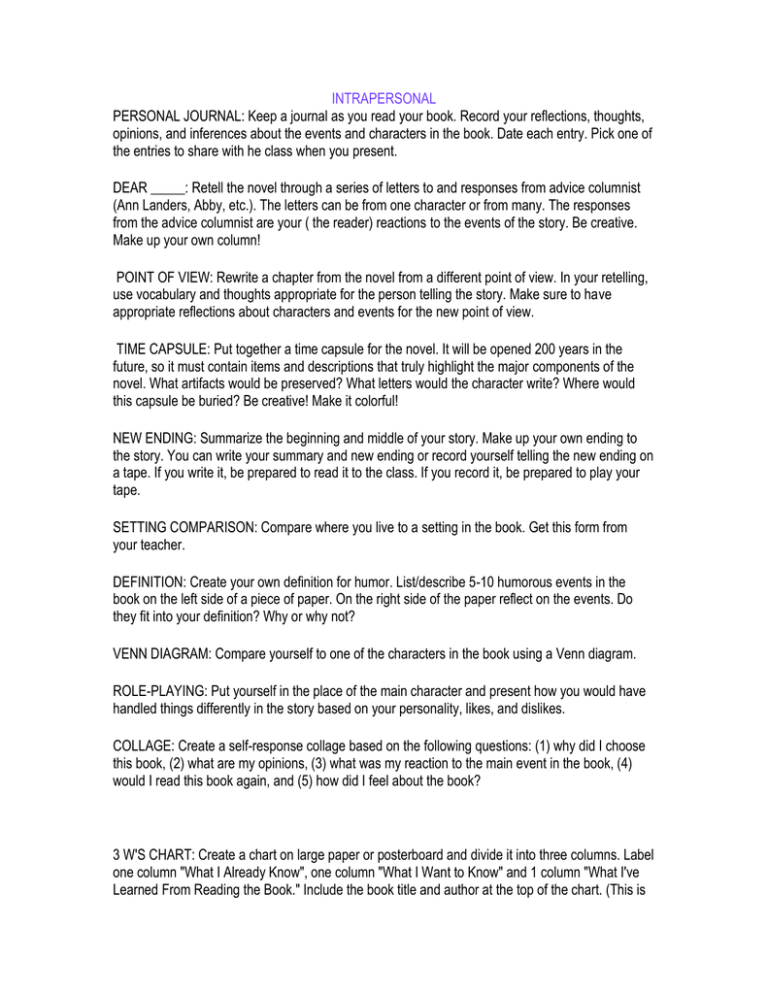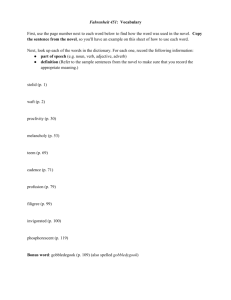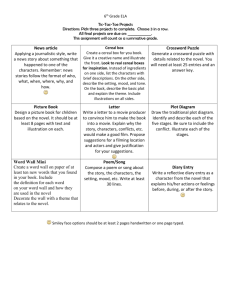File
advertisement

INTRAPERSONAL PERSONAL JOURNAL: Keep a journal as you read your book. Record your reflections, thoughts, opinions, and inferences about the events and characters in the book. Date each entry. Pick one of the entries to share with he class when you present. DEAR _____: Retell the novel through a series of letters to and responses from advice columnist (Ann Landers, Abby, etc.). The letters can be from one character or from many. The responses from the advice columnist are your ( the reader) reactions to the events of the story. Be creative. Make up your own column! POINT OF VIEW: Rewrite a chapter from the novel from a different point of view. In your retelling, use vocabulary and thoughts appropriate for the person telling the story. Make sure to have appropriate reflections about characters and events for the new point of view. TIME CAPSULE: Put together a time capsule for the novel. It will be opened 200 years in the future, so it must contain items and descriptions that truly highlight the major components of the novel. What artifacts would be preserved? What letters would the character write? Where would this capsule be buried? Be creative! Make it colorful! NEW ENDING: Summarize the beginning and middle of your story. Make up your own ending to the story. You can write your summary and new ending or record yourself telling the new ending on a tape. If you write it, be prepared to read it to the class. If you record it, be prepared to play your tape. SETTING COMPARISON: Compare where you live to a setting in the book. Get this form from your teacher. DEFINITION: Create your own definition for humor. List/describe 5-10 humorous events in the book on the left side of a piece of paper. On the right side of the paper reflect on the events. Do they fit into your definition? Why or why not? VENN DIAGRAM: Compare yourself to one of the characters in the book using a Venn diagram. ROLE-PLAYING: Put yourself in the place of the main character and present how you would have handled things differently in the story based on your personality, likes, and dislikes. COLLAGE: Create a self-response collage based on the following questions: (1) why did I choose this book, (2) what are my opinions, (3) what was my reaction to the main event in the book, (4) would I read this book again, and (5) how did I feel about the book? 3 W'S CHART: Create a chart on large paper or posterboard and divide it into three columns. Label one column "What I Already Know", one column "What I Want to Know" and 1 column "What I've Learned From Reading the Book." Include the book title and author at the top of the chart. (This is good for informational.) INTERPERSONAL NEWSCAST: Pretend that you are the anchor of a local news program. Give an editorial of your book. MISSING IN ACTION: The main character of you novel is missing. Develop a missing person's folder for the police department. Include interviews with key characters, clues concerning the missing person, and an official police report form. Use information from the novel as well as creative imagination to put the file together; compile all the pieces into a manila folder or file. TALK SHOW: Create a talk show in which audience members (classmates) have the opportunity to talk with the author (you) of your book. TIMELINE: Read the same book as a friend. Together create an illustrated timeline of the events in the book. INTERVIEW: Read the same book as a friend. One acts as the author or main character and the other interviews him/her. Make reference to the setting, problem, and character traits. GRAFFITI: Read the same book as a friend and create a graffiti poster. The poster should symbolize the traits of the main characters, most exciting event, and your opinions. COMMERCIAL: Read the same book as a friend. Each of you should choose a character from the book and dress up as him/her. Present a commercial that is at least three minutes long which encourages others to read the book. BOOK TRIAL: Read the same book as a partner. Each of you will be an attorney with an opinion of the book. Choose a Judge from the class to listen to each of your opinions about the book. The rest of the class will be the jury. Each attorney needs to present his/her ideas about the book( what he/she learned, was it interesting, should it be read by others, etc.) Have the class come to a verdict about the book at the end of each attorney's presentation. BOOK TALK: Read the same book as one or two other classmates. Hold a book talk in front of the class when you present. Summarize the plot and describe the characters when you discuss the book. Explain your thoughts and opinions about the book. Talk about what you liked and disliked. Make sure we can tell that you clearly understood the book by what you discuss. VISUAL SPATIAL CEREAL BOX ADVERTISEMENT: Paint or cover a cereal box with paper. Illustrate your a memorable event from the book. Make a list of ingredients that made your book good. Use specific adjectives to describe the characters and the plot. Be sure to include the title, author, your name, etc. COMIC STYLE: Relate the highlights of the novel in comic book form. Besides using drawings, include significant quotes from the novel. Work objects of symbolic importance into your illustrations. Design an appropriate cover for the comic book. Make sure to include the following in the comic book: setting, main characters, conflict, key events, and resolution of the conflict. The comic book must be at least 3 pages in length. (3 separate cartoon pages) PRODUCE IT: Produce your novel as a movie. Cast the major roles, draw costume designs, visualize setting locations, edit the novel, select appropriate background music and main theme music, identify special effects, write a radio commercial, design a poster, and decide upon the movie rating. Make sure all the sketches and pieces of this project are compiled together in a large envelope. Label each aspect of this project. STORY BOARD: Be a director for a film version of the novel. Before filming begins, a storyboard of the various scenes of the film must be prepared. A storyboard is a comic strip style summary of the action of a particular scene. It indicates camera angles, close-ups, etc. Choose two scenes from the novel and prepare storyboards for these scenes. SCRAPBOOK MEMORIES: Create a scrapbook for the main character based upon the novel. The scrapbook could contain pictures, mementos, postcards, etc. that detail the story. Each item in the scrapbook should have a note saying why it appears in the scrapbook. The book should also be in chronological order. Make it colorful and creative. BOOK CHARACTERS: Design a bookmark that represents a character in your book. Write the title of the book and the author of the book on the front. Inside or on the back write about the character's traits. COMPUTER PRESENTATION: Use Hyperstudio or Powerpoint to create a visual presentation summarizing the plot, introducing the main characters, and any other important information about the book. PUZZLE: Cut a large piece of paper into several pieces to create a puzzle. Write information and draw pictures about your book on each puzzle piece. Include the main characters, title, author, setting, main events, etc. BEDROOM: Think about the main character in your story. Design an ideal bedroom for him/her based on what you learned from the story. Think about personality, decisions made in the book, age, likes and dislikes, etc. MAP THE ACTION: Prepare a map of the places and landmarks mentioned in the novel. Use evidence from the story and creative imagination to situate the items. Then label each location with an event from the story. Maps must be colorful, appropriately labeled, and at least 9 X 12 inches in size. BOOK JACKET: Design an original book jacket for your book. Include author, illustrator, a full illustration, descriptive summary, and reviews by you. IDENTIKIT BOOK: Create a book for the main character in your book. See your teacher for the instruction sheet. T-SHIRT: Design a t-shirt that teaches others about your book. Use words, pictures, and/or designs to explain the characters, problem, setting, etc. GOIN' MOBILE: Create a mobile of the different components of the novel. Use note cards, cutout symbols or objects, etc. with a hanger and yarn. On each section of the mobile, write a paragraph to describe the component of the story. Include: setting, protagonist, antagonist, conflict, resolution, author's message, and opinion. The mobile should be colorful. THE NOVEL MUSEUM: Design a museum based upon the novel. Draw up floor plans showing how the museum is designed and where the different exhibits are. Write a brochure describing the different exhibits. Include sketches of what some of the different exhibits might look like, and be sure to include details, events, and characters from the book. Name the museum and make it colorful! MUSICAL RHYTHMIC SONG REMAKE: Take the words to a song that you know (Brady Bunch, Looney Tunes, etc.) and replace them with words to match your story. Include names of characters, main events, setting, etc. SONG: Find a song that relates to your book and play it for the class. Then give a one or two minute summary of the book and explain the importance of the song. GAME: Create a musical game based on your book. Be sure to include the characters, setting, problem, etc. SING IT: Imagine you are a musical director for a film version of the novel. Your task is to select music (jazz, blues, classical, rock, etc.) for ten major episodes of the novel. List the episodes and then make one or two recommendations for music to accompany each episode. Don't forget to include the artist or composer for each song. In addition, below each song, explain why each selection fits the mood and outcome of the scene. (Additional option: you may prepare a tape of your music and/or include a voice-over reading of the episodes. However, you must also do the first part of the project.) SONG REFLECTION: Choose a song that reflects the events in your book. Stop the song at certain points to explain what happened in the story that relates to parts of the song. (Ex, The beat is strong and fast which represents the high point of the story.) SOUND EFFECTS: Write a summary of the story. Produce sound effects that will bring your story to life. You may bring in a tape of your summary with the effects or you can read your summary and produce the effect during the reading. INSTRUMENTS: Choose four or five important events in your story. Create a musical instrument out of household items to represent each event. Play each instrument and explain why you chose it. THREE CHEERS: Create a cheer about your book. Be sure to include the main ideas from your book. LINGUISTIC LIMERICK: Write a limerick for each main character in your book, and present them to the class. Follow the correct format. PLAIN LITTLE 'OL ME: If you do not wish to take the creative route, write out a simple book report/review. It must be typed. Include well-organized paragraphs on the following: an intro, the setting (time and place), main characters and how they change, the overall plot, the main problem and its solution, and, as a conclusion, an opinion. Make a colorful or decorative cover. RULES: Choose a character from the book who might benefit from following a few simple rules. Write rules that reflect knowledge of the character's behavior and actions. NEWSPAPER ARTICLE: Write a newspaper article about a particular event in your story. Remember to include the who, what, when, where, why, and how. ABC BOOK: Create an ABC book based on a the events and characters in your story. You will need something for each letter of the alphabet. BUSINESS LETTER: Write a business letter to the author of the book. Include questions to him/her, thoughts on the book, and your opinions. Tell what your favorite part was and why. Remember to write in complete sentences and paragraphs. TRIVIA GAME: Create a trivial pursuit game based on your book. Include a gameboard, game pieces, questions, and answer cards. DICTIONARY: Create a dictionary of vocabulary words from your book. Definitions need to be in alphabetical order and in your own words. Include at least ten words. Pick an event that relates to each of your words. On the left side of the paper write your words and definitions and on the right side of your paper describe the events and how they fit your definition. RECIPE: Write a recipe for your book. Tell what ingredients make your book "delicious"" Give directions for how these ingredients are mixed together to make a great book. (Ex. Bake at 350 for twenty minutes and serve to any reader who is hungry for a good book.) POETRY BOOK: Compile a poetry book that includes acrostics, cinquains, diamante, comparison poems and bio poems that express all aspects of the novel. You must create at least five different poems based on the novel. Make a decorative or colorful cover for the booklet. Put each poem on a separate page. LOGICAL MATHEMATICAL GAME: Create a boardgame that is based on the plot of your book. Include directions, title, question and answer cards, and needed supplies. Be colorful, creative, and make sure your game follows a sequence. STORY CUBE: Complete a story map of the novel by highlighting the setting, conflict, resolution, characters, author's message, and your opinion on a 3-dimensional story cube. Get the format to create the cube from your teacher. Cubes must be decorated or illustrated with color. STORY LADDER: Create a ladder of the most important aspects of the novel. Use note cards or strips of paper and yarn to create a ladder. Describe each component of the story in one or two sentences for each part of the ladder. Include: setting, plot, conflict, resolution, characters, author's message, and your opinion. Make the ladder colorful by including illustrations or decorative borders. TANGRAMS: Tangrams are ancient Chinese puzzles used to tell stories. Use tangram pieces to summarize the beginning, middle, and end of your story. For example, if the beginning of your story takes place on a boat you might create a boat out of the tangrams. MATH BOOKLET: Create a math problem solving booklet about your book. Use characters and events from your book in your problems. Include the answers to each of your problems. BAR GRAPH: Follow these steps to create a bar graph showing the intensity of your story's events: (1) read your book, (2) identify and order 10 main event sin your story, (3) rate the intensity of the events on a scale of one to ten, (4) create a bar graph. Remember to label your graph. TECHNOLOGY PRESENTATION: Create a presentation analyzing the characters in your book. Give descriptions for each character and show how they change throughout the book. PROBLEM AND SOLUTION DIAGRAM: Create a diagram that shows the problem in your story and how it was solved. CHARACTER CHART: Create a character chart for the main characters in your story. Include each character's role in the story, character traits or personality, and how the character affected the story. BODILY KINESTHETIC ACT IT OUT: Act out your favorite scene from the book. Take on the mannerisms and personality of the main character in the book. SHOP 'TIL YOU DROP: A new mall is being developed and it is built along a special theme. The mall will be based on the main characters. All the stores in the mall will be connected to the main characters in some way. Design a 3-D layout of the mall, write a short brochure describing each store or business, and develop a flyer for the grand opening of the mall. Your mall should have at least ten different businesses in it. DRESS UP: Dress up like your favorite character. Play a game of charades in which you act out scenes from the book. PUPPET SHOW: Create a puppet show which includes the characters from your book. Act out the most important scene from your book using the puppets. SILENT SCENE: Act out the main event in the book using only movement (no words). At the end of your performance summarize/explain what you did. DANCE: Create and perform a dance that reflects the main event(s), main characters, or theme from your book. GAME: Invent a game based on your book that requires movement from those playing it (think Twister not Monopoly). Include the characters, sequence of events, problem, and solution. NATURALIST MOOD SORT: Choose ten events from your book. Sort them according to the mood/feelings that were created by the author when you wee reading. Include descriptive words used by the author to help create the mood. DIORAMA: Create a model or diorama of the setting of your book using natural materials such as sticks and grass. Use detail! MAP: Draw a map of where your story takes place. Include the natural landmarks in your story on the map. When you present you project make sure you tell about the key events in your story and show where they happen on your map. Connect the characters and events to the natural landmarks on your map.






